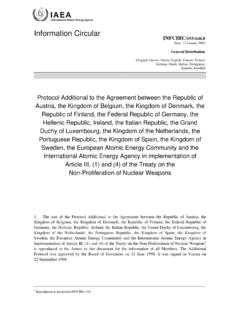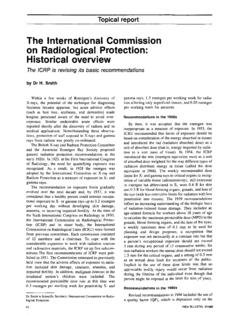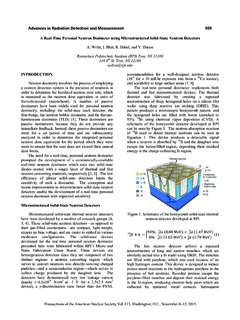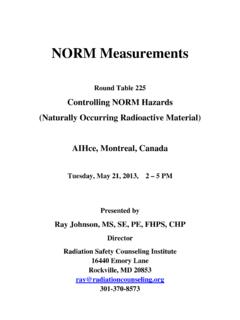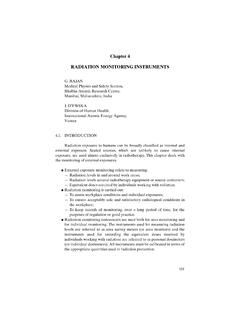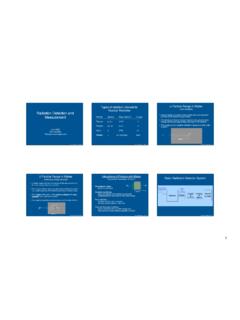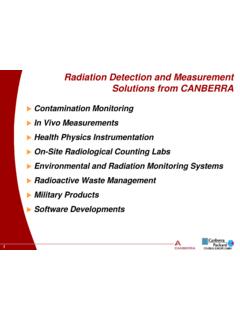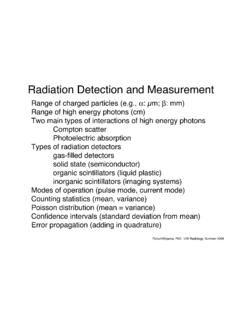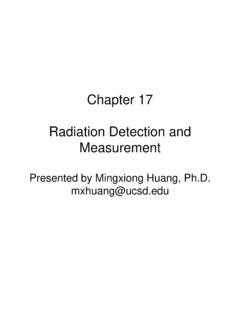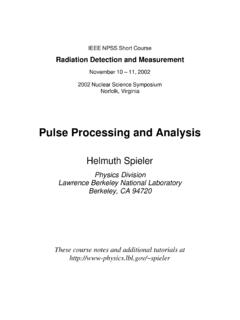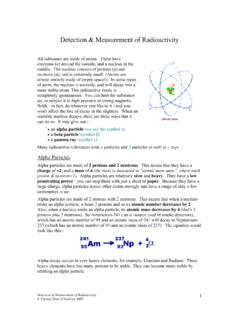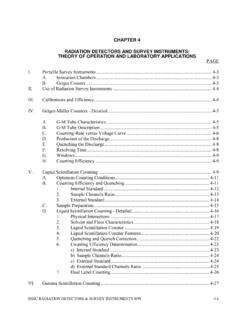Transcription of Detecting and measuring ionizing radiation - a …
1 radiation detectionDetecting and measuringionizing radiation - a short historyby Flakus* ionizing radiation causes neutral atoms or moleculesto acquire either a positive or negative electrical most commonly known types of ionizingradiation are alpha, beta, gamma, X, and neutron radiation , such as alpha or beta rays,has a direct ionizing effect; whereas neutral radiation ,such as X, gamma, or neutron rays, have an indirectionizing effect, these radiations first generate chargedparticles which then have the ionizing is a form of energy. This energy can bepartly or wholly deposited in a suitable medium andthus produce an effect. The detection and measurementof radiation is based upon the detection andmeasurement of its effects in a medium, and the historyof the emergence of radiation detectors is closelyrelated to the discovery of radiation and material emits ionizing radiation withouthaving been subject to any external influence.
2 Thetype of radiation emitted and its associated energy ischaracteristic for the kind of radioactive substance. Inmany applications of radiation detectors, the objectis to measure the energy distribution of the radiation (spectrometry).Although ionizing radiation has been present innature (cosmic rays, naturally occurring radioactivematerials) throughout man's history, it remainedunnoticed until less than 100 years ago. Man has nospecific sense which could have responded to this kind ofradiation and it had not been possible for scientificinitiative to develop any instruments that would haveamplified a human response to that radiation , as was thecase for example in the area of visible light waves(optics)As we know today, tools for Detecting ionizingradiation were, in principle, in existence rather early:the phenomenon of thermoluminescence was firstdescribed in the 17th century; the gold leaf electroscopewas invented in the 18th century; and photography wasdeveloped during the early 19th century.
3 Howevermany years passed until the doors to these completelynew fields of science were opened by Rontgenin 1895, and by H. Becquerel in 1896.* Mr Flakus is a staff member in the Radiological SafetySection of the IAEA's Division of Nuclear of radiation detectorsfrom the early discoveriesOn the evening of 8 November 1895, while workingin a carefully darkened room, Rontgen noticed that apiece of a cardboard coated with barium platinocyanideshowed a faint, flickering, greenish light (fluorescence)when electrical discharges took place in a Hittorf-Crookestube near the screen. The tube itself was carefully coveredwith a black shield impervious to any visible verified that the tube was the source of a newkind of radiation , which was invisible but which revealedits existence when hitting the luminescent subsequently performed many careful experimentson the radiation which he named X-rays.
4 His firstimportant step was to replace the fluorescent screen by aphotographic plate- this was susceptible to X-rays andthus provided a tool for recording X-ray 22 December 1895, Rontgen made the firstmedical X-ray photograph. It shows the hand of hiswife and marks the birth of radiography. Subsequently,mainly photographic plates were used in X-ray fluorescent screen lost importance, althoughfluoroscopes or sciascopes were improved by Magie, Thomson, and Edison. During his manyexperiments on X-rays, Rontgen also observed that airwould conduct electricity when traversed by the effect was later-used as the operating principle forseveral kinds of radiation detector. For his discovery,Rontgen was awarded the first Nobel Prize in Physics is interesting that the valuable possibilities of the useof X-rays for many purposes, medical and non-medical,became immediately apparent and that during thefollowing year, 1896, over 1000 articles and more than50 books were published on the subject.
5 Knowledge ofthe new findings spread along with ignorance andscattered opposition" for instance, it was proposed "toprohibit the use of X-rays in opera glasses at theatres"or "to burn all work on the X-rays and to execute allthe discoverers". One company "made a prey of ignorantwomen by advertising the sale of X-ray-proof under-clothing".In early work with X-rays it had been quicklyrecognized that the spot in the discharge tube where thecathode rays caused the emission of X-rays, wascharacterized by a strong fluorescence and a correlationIAEA BULLETIN, VOL 23, No 431 radiation detectionbetween this fluorescence and the emission of X-rays wassuspected. Following suggestions made by H. Poincare,Becquerel in 1896 undertook a systematic study of theconnection between the emission of visible light and ofX-rays. He wrapped phosphorescent substances, afterexposure to sunlight, in black paper and placed them onphotographic plates to detect any emission of happened that Becquerel started his experiments withhighly fluorescent uranium compounds.
6 He demonstratedthat the position of the uranium minerals was revealed byblack spots occurring on the developed photographic plateand that penetrating rays like X-rays were emitted. Whenhe later developed a photographic plate that had lain forseveral days in a drawer under a tray with uranium saltswhich had not been exposed to sunlight, he found thesame dark spots on the plate. He repeated the experimentand concluded that neither sunlight, phosphorescence norfluorescence was necessary to produce the effect, and thatinvisible rays were emitted from all uranium compoundsand from metallic uranium. This marks the discovery ofradioactivity m continued carefully to investigate theproperties of the rays. Among other important facts,he found that the rays discharged a charged electroscope(invented in 1787 by A. Bennett). After Becquerel'sdiscovery, scientists started the search for furtherelements with radiation -emitting already mentioned, one property of X-rays dis-covered very early was their ability to make dry airelectrically conductive, to liberate electrical chargesin air.
7 These charges could be collected by producing anelectric field across that volume of air. However, it wasnot until the work of Thomson in 1899 that theoperating characteristics of these ionization chamberswere well understood. Madame Sklodowska Curierealized that the ionization method of measuring theintensity of X-rays would be well suited to Detecting theradiation found by Becquerel. She equipped an electro-meter used by her husband Pierre Curie with a suitableionization chamber and repeated Becquerel's method proved very satisfactory. She found thatthe intensity of the radiation was proportional to theamount of uranium. In July 1898, together with herhusband, she discovered the radioactive elementpolonium. In December 1898 they announced thediscovery of radium. Together with Becquerel, they wereawarded the Nobel Prize for Physics in 1903.
8 It was alsoMadame Curie who proposed calling the new is interestmg to note that in 1899, J. Elster andH. Gertel, and independently Wilson, had foundthat an electroscope steadily lost charge withoutapparently being exposed to radiation , and suggestedthat this resulted from the presence of radioactivity inthe earth. The deflection of part of the "Becquerelrays" in a magnetic field was also noticed in 1899. Afew years later Rutherford succeeded in giving a completeexplanation of the nature of alpha, beta, and gamma the beginning of radium research work, thephotographic plate was used to study the new , ease of handling, relatively low cost and highsensitivity soon made the gold-leaf electroscope thepreferred measuring instrument for work with radio-active material. Various types of electroscopes weredeveloped for this purpose' the alpha electroscope,where the ionization chamber and the measuring chamberwere closely connected; the beta electroscope, whereionization chamber and measuring chamber werecombined, and the emanation electroscope for measuringradioactive gases.
9 The use of ionization chambers inconjuction with galvanometers remained restricted to themeasurement of intense radiation . The very earlydetection methods, namely the fluorescent screen, thephotographic plate, the gold-leaf electroscope, and theionization chamber in combination with an electroscopeor galvanometer, had one common characteristic: theycould only be used to respond to "bulk" radiation butthey were insensitive to single first instrument that was able to detect individualrays was the spinthariscope, invented by Crookes in1903. It had been discovered that the luminosity of azinc sulphide screen, when exposed to alpha particles,consisted of a number of individual scintillating points oflight that could be observed with a strong magnifyingglass. Rutherford and Geiger found that, on a uniformscreen, each scintillation corresponded to the impact ofone alpha particle only.
10 Thus a very simple method forcounting individual alpha particles was available whicheventually gained great practical importance. The methodwas refined and used most profitably by Rutherfordand his students and was extensively used for many yearsuntil the 1930s. However, it imposed considerablestrain and fatigue on the observers: the usual procedurewas for an observer to count for one minute, then berelieved by another observer. Each observer might haveto count for 20 periods of one minute each during instrument that made single radiation eventsvisible was the cloud chamber, first built in 1911 Wilson. A cloud chamber usually consists of aflat glass front-plate for observation, glass side-walls forillumination, backed by a movable piston in order toexpand the volume of the chamber in a small fraction ofa second.

